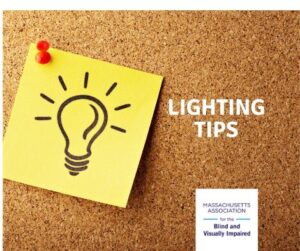Lighting Tips
 Our clients with vision impairments can get help from our Occupational Therapists with lighting in their homes or offices.
Our clients with vision impairments can get help from our Occupational Therapists with lighting in their homes or offices.
Two different types of lighting are:
- Ambient lighting—gives light for large areas so one can see to walk around safely.
a. ceiling lights
b. table lamps
c. floor lamps - Task lighting—specific lighting, aiming down onto a specific task, such as:
a. Writing
b. Reading
c. Working on the kitchen counter
Light adds contrast. There are different temperatures of lighting as there is no right lighting for the same task for everyone.
Some people prefer a warm or soft light, some a bright white light, and some daylight. The temperature for these lights varies by the intensity of Kelvin (K):
- Warm or soft light: more yellow, with lower K numbers (2700-3000)
- Daylight (or natural light): has less yellow, brighter with medium K numbers (3500-4100)
- Bright white: least amount of yellow, almost blue, with the highest K numbers (5000-6500)
Another way to determine the brightness of a light is to note the Lumens, or the output of light.
LED (light-emitting diode) lights are strongly recommended nowadays, as incandescents—while still available—are no longer manufactured. Some stores still have them as they bring them from their warehouses, but that supply will end eventually. CFLs (compact fluorescent lights) are no longer made due to the mercury in them and their improper disposal issues.
Heat from lights is very important as the closer the light to you the more important the comfort level:
- Incandescents and Halogens—give off the most heat
- CFLs—give off a lot less heat
- LEDs—give off no heat and are cool to the touch
Most people with vision impairments prefer warm light because it is more comfortable and doesn’t hurt their eyes. However, it gives the least amount of contrast when trying to read, unless positioned correctly. Occupational Therapists instruct positioning of task lamps to put light on the task at hand and not in the eyes, or give off glare.
LEDs are available now in all temperatures and base types: medium, intermediate, candelabra and pin:
The lower the wattage (watts is the energy needed to power the light bulb), the less bright it will be. Having said that:
- 60 watt incandescent >
- 60 watt equivalent CFL (~15 watts) >
- 60 watt equivalent LED (~9 watts)
Once the correct light for someone is determined, the next thing to do is find the correct lamp. There are different types of desk lamps: gooseneck lamps, articulating lamps, and bar lamps. Depending on the amount of light one needs the lamp chosen can be positioned to put the correct amount of light on the task.
The specific task lamp is dependent on the person’s need for lighting a specific area.
The positioning of the lamp head is dependent on what a person is trying to illuminate and the working distance one must maintain to see a book, write a note or cut an onion.
